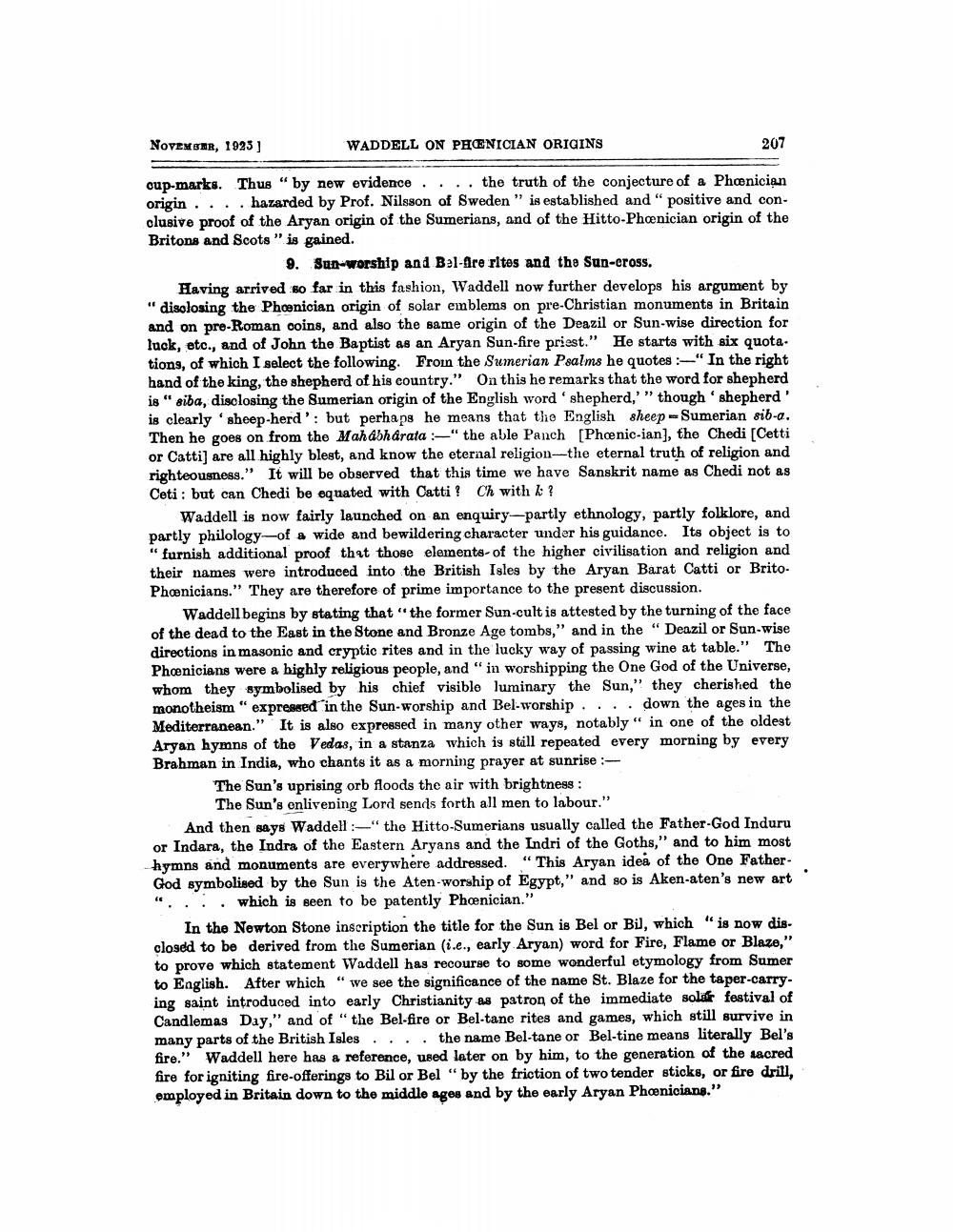________________
NOVEMSNR, 1923]
WADDELL ON PHENICIAN ORIGINS
207
cup-marks. Thus" by new evidence. ... the truth of the conjecture of a Phænician origin.... hazarded by Prof. Nilsson of Sweden " is established and a positive and conclusive proof of the Aryan origin of the Sumerians, and of the Hitto-Phoenician origin of the Britons and Scots" is gained.
9. Sun-worship and Bel-fire rites and the Sun-cross, Having arrived so far in this fashion, Waddell now further develops his argument by "disclosing the Phoenician origin of solar einblems on pre-Christian monuments in Britain and on pre-Roman coins, and also the same origin of the Deazil or Sun-wise direction for luck, etc., and of John the Baptist as an Aryan Sun-fire priest." He starts with six quota. tions, of which I select the following. Froin the Sumerian Psalms he quotes “In the right hand of the king, the shepherd of his country." On this he remarks that the word for shepherd is " siba, disclosing the Sumerian origin of the English word ' shepherd,' " though shepherd' is clearly 'sheep-herd': but perhaps he means that the English sheep-Sumerian sib-a. Then he goes on from the Mahabharata "the able Panch [Phoenic-ian), the Chedi [Cetti or Catti) are all highly blest, and know the eternal religion--the eternal truth of religion and righteousness." It will be observed that this time we have Sanskrit name as Chedi not as Ceti: but can Chedi be equated with Catti! Ch with k ?
Waddell is now fairly launched on an enquiry--partly ethnology, partly folklore, and partly philology-of a wide and bewildering character under his guidance. Its object is to "furnish additional proof that those elements of the higher civilisation and religion and their names were introduced into the British Isles by the Aryan Barat Catti or Brito Phoenicians." They are therefore of prime importance to the present discussion.
Waddell begins by stating that the former Sun-cult is attested by the turning of the face of the dead to the East in the Stone and Bronze Age tombs," and in the "Deazil or Sun-wise directions in masonic and cryptic rites and in the lucky way of passing wine at table." The Phoenicians were a highly religious people, and " in worshipping the One God of the Universe, whom they symbolised by his chief visible luminary the Sun," they cherished the monotheism "expressed in the Sun-worship and Bel-worship. ... down the ages in the Mediterranean." It is also expressed in many other ways, notably" in one of the oldest Aryan hymns of the Vedas, in a stanza which is still repeated every morning by every Brahman in India, who chants it as a morning prayer at sunrise :
The Sun's uprising orb floods the air with brightness :
The Sun's enlivening Lord sends forth all men to labour." And then says Waddell :-" the Hitto-Sumerians usually called the Father-God Induru or Indara, the Indra of the Eastern Aryans and the Indri of the Goths," and to him most hymns and monuments are everywhere addressed. “This Aryan idea of the One FatherGod symbolised by the Sun is the Aten-worship of Egypt," and so is Aken-aten's new art ".... which is seen to be patently Phoenician.'
In the Newton Stone inscription the title for the Sun is Bel or Bil, which is now dis. closed to be derived from the Sumerian (ie., early Aryan) word for Fire, Flame or Blaze," to prove which statement Waddell has recourse to some wonderful etymology from Sumer to English. After which " we see the significance of the name St. Blaze for the taper-carrying saint introduced into early Christianity as patron of the immediate sola festival of Candlemas Day," and of the Bel-fire or Bel-tane rites and games, which still survive in many parts of the British Isles.... the name Bel-tane or Bel-tine means literally Bel's fire." Waddell here has a reference, used later on by him, to the generation of the sacred fire for igniting fire offerings to Bil or Bel" by the friction of two tender sticks, or fire drill, employed in Britain down to the middle ages and by the early Aryan Phænicians."




